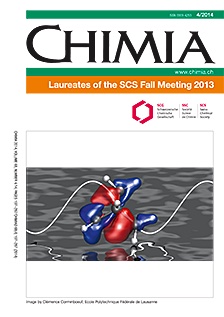Gas-phase Lifetimes of Nucleobase Analogues by Picosecond Pumpionization and Streak Techniques
DOI:
https://doi.org/10.2533/chimia.2014.260Keywords:
2-aminopurine, Lifetimes, Picosecond pump-ionization, Picosecond streak camera, 2-pyridoneAbstract
The picosecond (ps) timescale is relevant for the investigation of many molecular dynamical processes such as fluorescence, nonradiative relaxation, intramolecular vibrational relaxation, molecular rotation and intermolecular energy transfer, to name a few. While investigations of ultrafast (femtosecond) processes of biological molecules, e.g. nucleobases and their analogues in the gas phase are available, there are few investigations on the ps time scale. We have constructed a ps pump-ionization setup and a ps streak camera fluorescence apparatus for the determination of lifetimes of supersonic jet-cooled and isolated molecules and clusters. The ps pump-ionization setup was used to determine the lifetimes of the nucleobase analogue 2-aminopurine (2AP) and of two 2AP?(H2O)n water cluster isomers with n=1 and 2. Their lifetimes lie between 150 ps and 3 ns and are strongly cluster-size dependent. The ps streak camera setup was used to determine accurate fluorescence lifetimes of the uracil analogue 2-pyridone (2PY), its self-dimer (2PY)2, two isomers of its trimer (2PY)3 and its tetramer (2PY)4, which lie in the 7–12 ns range.Downloads
Published
2014-04-30
Issue
Section
Scientific Articles
License
Copyright (c) 2014 Swiss Chemical Society

This work is licensed under a Creative Commons Attribution-NonCommercial 4.0 International License.
How to Cite
[1]
S. Blaser, H.-M. Frey, C. G. Heid, S. Leutwyler, Chimia 2014, 68, 260, DOI: 10.2533/chimia.2014.260.







